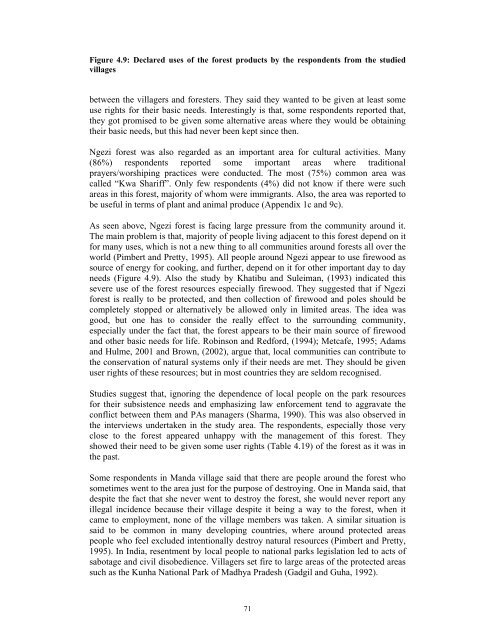serikali ya mapinduzi zanzibar care tanzania and department
serikali ya mapinduzi zanzibar care tanzania and department
serikali ya mapinduzi zanzibar care tanzania and department
You also want an ePaper? Increase the reach of your titles
YUMPU automatically turns print PDFs into web optimized ePapers that Google loves.
Figure 4.9: Declared uses of the forest products by the respondents from the studied<br />
villages<br />
between the villagers <strong>and</strong> foresters. They said they wanted to be given at least some<br />
use rights for their basic needs. Interestingly is that, some respondents reported that,<br />
they got promised to be given some alternative areas where they would be obtaining<br />
their basic needs, but this had never been kept since then.<br />
Ngezi forest was also regarded as an important area for cultural activities. Many<br />
(86%) respondents reported some important areas where traditional<br />
prayers/worshiping practices were conducted. The most (75%) common area was<br />
called “Kwa Shariff”. Only few respondents (4%) did not know if there were such<br />
areas in this forest, majority of whom were immigrants. Also, the area was reported to<br />
be useful in terms of plant <strong>and</strong> animal produce (Appendix 1c <strong>and</strong> 9c).<br />
As seen above, Ngezi forest is facing large pressure from the community around it.<br />
The main problem is that, majority of people living adjacent to this forest depend on it<br />
for many uses, which is not a new thing to all communities around forests all over the<br />
world (Pimbert <strong>and</strong> Pretty, 1995). All people around Ngezi appear to use firewood as<br />
source of energy for cooking, <strong>and</strong> further, depend on it for other important day to day<br />
needs (Figure 4.9). Also the study by Khatibu <strong>and</strong> Suleiman, (1993) indicated this<br />
severe use of the forest resources especially firewood. They suggested that if Ngezi<br />
forest is really to be protected, <strong>and</strong> then collection of firewood <strong>and</strong> poles should be<br />
completely stopped or alternatively be allowed only in limited areas. The idea was<br />
good, but one has to consider the really effect to the surrounding community,<br />
especially under the fact that, the forest appears to be their main source of firewood<br />
<strong>and</strong> other basic needs for life. Robinson <strong>and</strong> Redford, (1994); Metcafe, 1995; Adams<br />
<strong>and</strong> Hulme, 2001 <strong>and</strong> Brown, (2002), argue that, local communities can contribute to<br />
the conservation of natural systems only if their needs are met. They should be given<br />
user rights of these resources; but in most countries they are seldom recognised.<br />
Studies suggest that, ignoring the dependence of local people on the park resources<br />
for their subsistence needs <strong>and</strong> emphasizing law enforcement tend to aggravate the<br />
conflict between them <strong>and</strong> PAs managers (Sharma, 1990). This was also observed in<br />
the interviews undertaken in the study area. The respondents, especially those very<br />
close to the forest appeared unhappy with the management of this forest. They<br />
showed their need to be given some user rights (Table 4.19) of the forest as it was in<br />
the past.<br />
Some respondents in M<strong>and</strong>a village said that there are people around the forest who<br />
sometimes went to the area just for the purpose of destroying. One in M<strong>and</strong>a said, that<br />
despite the fact that she never went to destroy the forest, she would never report any<br />
illegal incidence because their village despite it being a way to the forest, when it<br />
came to employment, none of the village members was taken. A similar situation is<br />
said to be common in many developing countries, where around protected areas<br />
people who feel excluded intentionally destroy natural resources (Pimbert <strong>and</strong> Pretty,<br />
1995). In India, resentment by local people to national parks legislation led to acts of<br />
sabotage <strong>and</strong> civil disobedience. Villagers set fire to large areas of the protected areas<br />
such as the Kunha National Park of Madh<strong>ya</strong> Pradesh (Gadgil <strong>and</strong> Guha, 1992).<br />
71

















